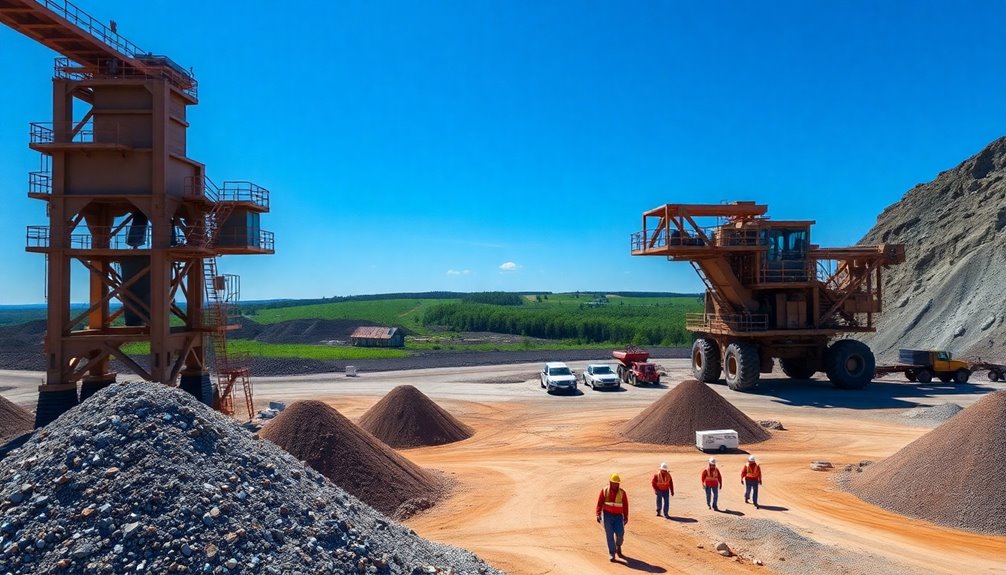When exploring the top 10 mining PPMs, you'll see how companies like Hudbay Minerals, Capstone Copper, and First Quantum Minerals have expertly navigated private placements to secure vital funding. These placements are essential for supporting projects, from exploration to development, often focused in resource-rich areas like Canada and Chile. They highlight the importance of tailored offerings that meet SEC regulations and investor needs. The recent surge in mining financing shows a growing market confidence. If you're curious about specific successes and strategies behind these placements, there's much more to uncover.
Key Takeaways
- Successful mining PPMs often utilize strategic partnerships to enhance funding potential, as seen with Capstone Copper's collaboration with Orion.
- High-profile placements, like First Quantum Minerals' $1.6 billion in senior secured notes, demonstrate the effectiveness of leveraging diverse financing strategies.
- Companies focus on geographical hotspots, with significant mining projects concentrated in Canada and Chile, attracting investor interest.
- The sharp increase in mining financing, exemplified by a 163% rise in February 2024, indicates strong market confidence and demand for critical minerals.
- Efficient use of proceeds in exploration, development, and operational costs is crucial for advancing projects and securing investor trust in private placements.
Overview of Mining PPMs

Mining Private Placement Memorandums (PPMs) serve as vital tools for raising capital in the mining sector, especially when you need to attract investors through private placements of securities. These documents provide essential details about the offering, including the attributes of the securities, the intended use of proceeds, and the associated risks.
By disclosing comprehensive information, PPMs protect you against potential claims of misstatements or omissions, ensuring that investors can make informed decisions based on your business strategy, market opportunities, and financial projections. Thorough preparation is essential for creating an effective PPM that meets SEC standards and informs potential investors.
Key components of a PPM include the summary of offering terms, a description of the securities, and an estimated use of proceeds. You'll also need to disclose management fees, placement agent commissions, and other related expenses.
Compliance with regulatory frameworks, such as SEC Rules 504, 505, and 506 of Regulation D, is crucial. Additionally, adhering to Canadian securities laws and ensuring continuous disclosure filings are necessary steps to maintain compliance.
Incorporating effective strategies, like engaging dealers or underwriters and utilizing flow-through shares, can enhance your capital-raising efforts.
Preparing well in advance is key to executing a successful private placement, allowing you to navigate this complex landscape confidently.
Hudbay Minerals Inc

Hudbay Minerals Inc. stands out as a significant player in the mining industry, particularly known for its strategic approach to private placements. The company has effectively utilized these financing methods to advance specific mining projects across Canada. For instance, its $95 million private placement with Skye Resources Inc. aimed to boost exploration and development activities, demonstrating a clear intent to enhance operational capabilities.
In 2005, Hudbay announced private placement financing, which included collaboration with a syndicate of investment dealers led by GMP Securities Ltd. This strategic partnership facilitated the successful fundraising for ongoing initiatives.
Notably, in 2006, Hudbay completed a flow-through share placement, allowing for additional capital to further improve resource extraction efficiency. This initiative generated approximately $20 million in gross proceeds for exploration and development.
Hudbay's acquisition of 96,997,492 common shares in Lundin Mining, valued at roughly 19.9% of Lundin's capital, exemplifies the company's proactive approach to expanding its portfolio. This acquisition closed in December 2008, aligning perfectly with Hudbay's long-term project timelines.
Capstone Copper Corp

Capstone Copper Corp. has emerged as a significant player in the copper mining sector, leveraging strategic partnerships and financing activities to fuel its growth.
In February 2024, Capstone and Orion completed a $431 million bought deal public offering, selling a combined total of 68,448,000 common shares at $6.30 each. This transaction, managed by a syndicate of underwriters co-led by RBC Capital Markets, generated $356 million for Capstone alone, bolstering its financial position. The offering included full exercise of the over-allotment option, highlighting strong demand for the shares.
In April 2024, Orion sold an 8.3% stake in Capstone for approximately AUD $592.8 million, reducing its stake to 12%. This move attracted new blue-chip investors, diversifying Capstone's shareholder base and positioning it for potential inclusion in major indices like ASX300 and ASX200.
Additionally, a C$328 million secondary offering in March 2023 further demonstrated Capstone's ability to raise capital effectively.
Orion's ongoing partnership has been invaluable since their initial collaboration in 2015, leading to operational improvements and sustainability initiatives.
With a market capitalization of around $4 billion, Capstone is well-positioned as a leading global copper producer, thanks in part to these strategic moves.
First Quantum Minerals

As First Quantum Minerals navigates the complexities of the mining sector, its recent refinancing initiatives reflect a strategic approach to enhancing liquidity and supporting growth.
The company successfully offered $1,600 million in senior secured second lien notes due in 2029 and raised $1,000 million through an equity bought deal at C$11.10 per share. This capital will help redeem all outstanding senior notes due in 2025 and 2026, while extending its corporate bank facilities to April 2027. The total debt includes $144 million in trading facilities, which adds further financial flexibility.
These moves not only enhance First Quantum's liquidity profile but also fund the critical S3 Expansion project at Kansanshi.
By amending and extending its corporate bank facilities, the company has revised its leverage covenant to adjust net debt/EBITDA ratios until 2027, allowing for more financial flexibility.
With a strengthened balance sheet, First Quantum is poised to return to strong free cash flow generation post-expansion.
The commitment to operational excellence at its Zambian operations and collaboration with the Government of Panama on Cobre Panamá signals a focused dedication to sustainable growth, paving the way for potential future initiatives, including asset and stake sales.
Western Copper and Gold Corp

With a focused vision on developing its Casino Project in the Yukon, Western Copper and Gold Corp stands out in the mining sector. This company trades on both the Toronto Stock Exchange and NYSE American under the ticker WRN. Its commitment to the Casino Project, which boasts significant reserves of 14.5 million ounces of gold, 7.6 billion pounds of copper, and 113.5 million ounces of silver, showcases its strong resource base. The Casino Project also includes substantial resources in gold, copper, and molybdenum, further enhancing its attractiveness to investors.
Recently, Western Copper raised C$5 million through a private placement with Rio Tinto Canada Inc. and upscaled a public offering to $40 million. Their prudent financial management has been instrumental in advancing the Casino project. They've also engaged in community-focused initiatives and submitted an updated Environmental and Socio-economic Effects Statement to YESAB.
Led by CEO Sandeep Singh, with a team of seasoned professionals, Western Copper prioritizes environmental responsibility and community engagement. The ongoing metallurgical testing program further emphasizes their commitment to developing Canada's premier copper-gold mine.
Solaris Resources Inc

Building on the momentum in the mining sector, Solaris Resources Inc is carving its niche as a prominent player in copper and gold exploration across the Americas.
Based in Vancouver, BC, this company trades on both the Toronto Stock Exchange and NYSE American, focusing on high-potential projects in regions known for their stability and rich resources. Solaris boasts key assets like the Warintza property in Ecuador, which covers 26,777 hectares and holds significant copper-molybdenum-gold potential. The Ricardo property near Calama, Chile, and the Tamarugo target in northern Chile further enhance its portfolio.
With a dedicated team of 60 employees and part of the Augusta Group, Solaris is well-poised for growth. Notably, the company's average market capitalization of 498M CAD reflects its strong standing in the competitive landscape.
Financially, Solaris has demonstrated resilience, with a notable 34.29% increase at the start of the year. They're committed to de-risking their projects while ensuring sustainability and social responsibility.
Recent management changes, including the appointment of Matthew Rowlinson as CEO, signal a proactive approach to navigating the industry's challenges. As they gear up for a growth-oriented spin-out in 2025, Solaris is setting the stage for a promising future in mining.
Participation Types in Financings

Understanding participation types in financings is crucial for both companies and investors looking to navigate the complexities of private placements. You'll find that accredited investor requirements play a significant role in these offerings. To qualify, you need a net worth of at least $1 million, excluding your primary residence, or an annual income of $200,000 (or $300,000 combined with a spouse) for the last two years.
When it comes to brokered versus non-brokered offerings, brokered placements involve a brokerage house acting as a middleman, usually requiring a commission ranging from 6% to 10%. Non-brokered placements can save companies money, as investors deal directly with the issuer. However, brokered financings can broaden capital access and demonstrate market support. Additionally, investor relations personnel play a vital role in assisting with the process, ensuring a smoother experience for potential investors.
The terms and conditions of private placements often include warrants or flow-through shares, which may offer tax benefits for specific uses. To participate, you'll need to express your interest to the company, review a private placement memorandum, and complete necessary documentation.
Keep in mind that companies may prioritize allocations for management and institutional investors, so being proactive is essential in this competitive landscape.
Geographical Focus of Projects

The geographical focus of mining projects plays a vital role in determining their potential for success and investment appeal. For instance, companies like Hudbay Minerals Inc. and Capstone Copper Corp. emphasize locations in the Americas, particularly Canada and Chile. Their projects, such as the Copper Mountain and Mantoverde, highlight the rich mineral resources available in these regions, drawing investor interest.
In North America, mining firms like Faraday Copper Corp. target the Copper Creek project in Arizona, while IsoEnergy Inc. operates in the Athabasca basin of Canada. These locations benefit from established mining infrastructure, regulatory frameworks, and skilled labor, making them attractive to investors. The recent surge in capital raising indicates a strong investor confidence in these regions.
In South America, companies like Solaris Resources and Adventus Mining Corporation focus on Ecuador and Chile, leveraging the region's mineral wealth. Projects such as Warintza and Curipamba demonstrate strong investment potential, given the growing global demand for copper and other metals.
Other regions, like Australia, also present opportunities, as seen with New World Resources Ltd. and Rex Minerals Ltd. Ultimately, the geographical focus of these projects significantly influences their viability and attractiveness to potential investors.
Purpose of Funding

While securing funding is crucial for mining projects, it serves multiple purposes that are essential for their success. First, you'll need funds for exploration activities like drilling, sampling, and geological studies. These are vital for identifying potential resources. Additionally, many mining issuers are increasingly opting for private placements as a preferred method of raising capital to support these activities.
Development expenses, including feasibility studies, permits, and infrastructure development, are also covered by this funding. If you're working on Canadian projects, remember that proceeds from flow-through shares must be spent on prescribed exploration and development expenses.
Operational costs are another key area where financing comes into play. You'll need capital to cover salaries, equipment, maintenance, and legal fees. This helps manage cash flow and ensures ongoing operations run smoothly.
Additionally, funding supports marketing and corporate activities, which include investor relations and environmental compliance.
Lastly, you'll use funds to advance projects from exploration to production stages. This includes securing permits, enhancing project viability through research, and developing necessary infrastructure.
Market Impact Analysis

Funding not only supports the operational and developmental aspects of mining projects but also significantly influences market dynamics.
In February 2024, for instance, the mining sector saw a remarkable 163% increase in financing, amounting to nearly $2 billion. This surge reflects heightened market confidence and investor sentiment, particularly towards companies like Western Copper and Gold Corp. and Solaris Resources Inc., which successfully raised substantial funds. This increase in financing activity underscores the importance of liquidity in mining operations as companies seek to strengthen their financial positions.
The growing global demand for critical minerals, especially copper, drives these capital raisings. Junior resource companies, in particular, thrive during commodity price increases, making them attractive investments.
Even amidst fluctuations—like the 21% drop in M&A activity compared to the previous quarter—the sector's growth remains evident, with total deal volumes increasing by 15%.
Strategic partnerships, such as Eldorado Gold Corp.'s investment in AMEX Exploration Inc., enhance project credibility and funding potential.
As funds are channeled toward exploration and project advancements, the mining industry's expansion becomes tangible.
Frequently Asked Questions
What Are the Typical Terms of a Mining Private Placement?
In a mining private placement, you'll typically encounter units that combine a common share with additional securities like warrants.
These warrants let you buy more shares at a set price within a specific timeframe.
Often, units are priced below the current market price to offset liquidity concerns.
You'll also find terms that include a four-month resale restriction on the securities, impacting your ability to sell them quickly.
How Do Investors Assess Risk in Mining Investments?
When you assess risk in mining investments, you consider several key factors.
First, evaluate the geological potential and project stage, as earlier stages carry more risk.
Next, analyze financial health, including capital raised and cash flow management.
Don't overlook market conditions and global demand for the mineral.
What Regulatory Requirements Govern Mining Private Placements?
When you're looking into mining private placements, you need to understand several regulatory requirements.
In Canada, these offerings often rely on prospectus exemptions under National Instrument 45-106. You'll typically need to be an accredited investor, meeting specific financial criteria.
The issuer must provide a private placement memorandum (PPM) with essential information, but it won't be reviewed by regulators.
Make sure to comply with all relevant documentation and disclosure requirements to avoid potential issues.
How Can Companies Improve Their Chances of Successful Placements?
To improve your chances of successful placements, focus on selecting high-potential projects that align with current market demands.
Ensure you have robust financial planning in place, detailing how funds will be used to build trust. Engage actively with investors and maintain transparent communication about progress and performance.
Timing matters too; conduct placements during favorable market conditions and stay responsive to trends.
Lastly, demonstrate a commitment to environmental and social responsibility to attract ethical investors.
What Are the Tax Implications for Investors in Mining PPMS?
When you invest in mining private placements, you can enjoy significant tax benefits, particularly through flow-through shares.
You can deduct your purchase cost from your income, which means potential savings. If you donate these shares to charity, you avoid capital gains tax and gain a charitable donation credit.
However, be aware that new rules may introduce deemed capital gains tax upon donation, affecting your overall tax situation.
Always consult a tax professional for tailored advice.
Conclusion
In conclusion, understanding the dynamics of successful mining private placements is crucial for investors. By analyzing companies like Hudbay Minerals and Capstone Copper, you can identify key trends in participation types and geographical focus. Recognizing the purpose of funding and its market impact helps you make informed decisions. As the mining sector evolves, staying updated on these placements positions you to seize opportunities and navigate potential risks effectively.










